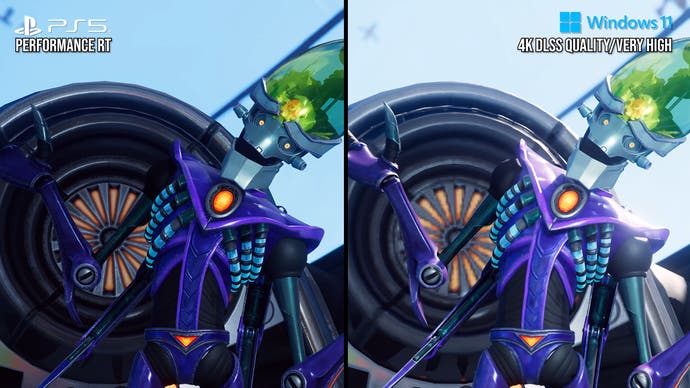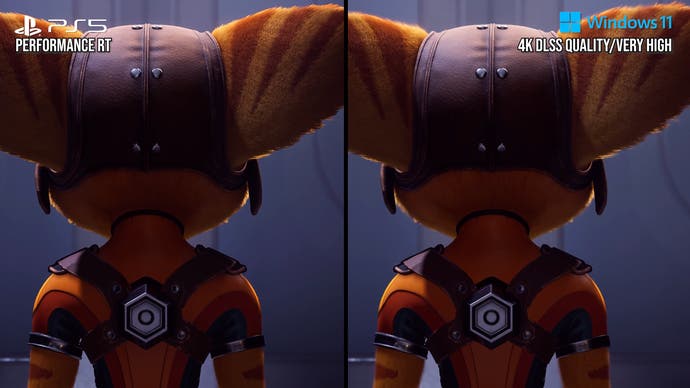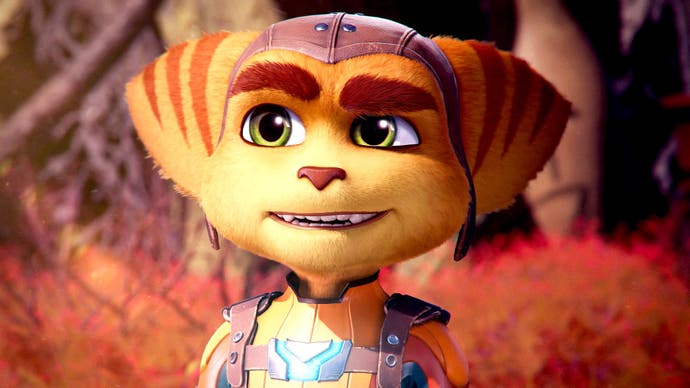Ratchet and Clank: Rift Apart PC tech analysis - this port needed more time
Impressive tech, great scalability, but a host of issues to address.
Ratchet and Clank: Rift Apart is out now on PC, two years after it launched as a PS5 exclusive. It's always fascinating to see how Sony's flagship titles fare on PC, especially those produced by porting specialist Nixxes. Rift Apart is also a cutting-edge effort - it's one of the first to support DirectStorage GPU decompression, which ought to shrink load times and raise performance. This analysis reviews the quality of the PC port at launch (with some commentary on the new patch that just 'dropped') with derived PS5-equivalent and optimised settings for a range of hardware, plus DirectStorage 1.2 tests. There's plenty to praise from Insomniac's latest PC release - along with a litany of graphical bugs and issues that suggest the game needed a little more time in the oven.
Ratchet and Clank's options are immediately familiar to anyone that's played Nixxes' Spider-Man PC ports, with a real-time tweaking menu and a good array of options for users to take advantage of including upscaling options from all GPU vendors. The settings menu is generally easy to use - though a flash effect when making changes sometimes obscures the nature of the change. Weirdly though, the main menu runs below 60fps on mid-range hardware without obvious CPU or GPU utilisation.
There are more serious issues elsewhere in the game, which suggest Rift Apart has launched without the typical polish we'd expect from a Nixxes release. For example, we experienced a handful of game crashes on a range of hardware within the first few hours of play, from a high-end Core i9 12900K and RTX 4090 rig to a minimum-spec build with the Ryzen 3 3100 and RX 570.
On top of this there are a number of inexplicable graphical regressions on PC, some of which have been fixed in a post-launch patch, including missing transparency effects, opacity and 'flaring' issues on some transparencies, texture filtering sometimes not working and a number of textures never loading to even PS5 quality. Combined with gameplay bugs, RT setting inconsistencies and the game's lack of support for RT on AMD hardware, the game isn't putting its best foot forward. Yet again, a PC port - and a Sony game - launches when it's clearly not ready.
Before we tackle those issues in more detail, it's worth underscoring that Rift Apart does push graphical fidelity beyond PS5 with its PC release, most notably with higher resolutions and better upscaling/anti-aliasing techniques - eg DLSS, which produces less ghosting and aliasing in motion than the PS5's 'Insomniac Games Temporal Injection' (IGTI). XeSS, FSR2 and the aforementioned IGTI are all viable options here, with DLSS typically producing the best results. FSR2 exhibits the most obvious artefacting, so we'd recommend DLSS if available and if you're not using high RT (where DLSS has some issues with reflections), then XeSS or IGTI, then FSR2.
Another advantage to the PC release is the ability to use full-resolution rather than checkerboarded RT reflections, which makes reflections cleaner and more stable than on PS5 - especially when combined with DLSS.
RT shadows are also available, which increase the quality and distance at which shadows are drawn, with the penumbra effects and fewer graphical oddities that we'd expect from a more realistic solution. However, the relatively low-quality BVH structure (the actual 3D models rays are traced against) used in these Insomniac games does expose some alignment issues between shadows and their caster, most prominently grass which exhibits blocky shadows in the launch version of the game, visible in the video above.
I'd argue a higher quality BVH option is needed to solve these quality issues and to take full advantage of higher-powered RT hardware on PC. BVH quality on PC also exhibited some issues in the launch version, where some objects like trees seemed to use the wrong LOD models in reflections and therefore appeared worse at max settings than PS5. This has been fixed in the first title update, thankfully.
RTAO is a new addition for this release and refers to ray-traced ambient occlusion which better grounds objects in the game world and helps dark cavities - like the inside of a hollow log, for example - appear realistically dark. There are dials to adjust its performance too, although again there are some minor bugs regardless of setting.


Based on the game's presentation at launch, I'd recommend most users with RT hardware to use RT reflections alone, while those with ultra-high-end GPUs could use RTAO as well. Beyond RT, there are relatively few upgrades for the PC release, with the new ultra level of detail distance option being the most impressive upgrade. This pushes object draw distance much further, with PS5 in its performance RT mode generally sitting between medium and high.
In terms of PS5-equivalent and optimised settings, Ratchet and Clank: Rift Apart bears many similarities and only a few differences compared to the previous Nixxes release, Spider-Man: Miles Morales. To summarise, most settings have clear PS5 equivalents, but a handful are somewhere between medium and high, with a few settings not showing any noticeable differences between these two presets on PC. My optimised settings are also similar to Miles Morales, with some adjustments as Rift Apart is heavier on the GPU in general.
When playing with optimised settings on an RTX 2070 Super, I noticed that the game's dynamic resolution scaling wasn't quite able to keep this setup locked to 60fps at a 1440p output resolution - something that was possible in the lighter Spider-Man: Miles Morales on the same PC. Using VRR if available to smooth out small frame-rate blips is therefore recommended. Secondly, available VRAM can be used up by background programs, so it's worth shutting down chat apps, RGB lighting software, games stores and the like - closing around dozen background programs saw a significant (25-50 percent) boost in frame-rates, as the GPU was able to keep more data in VRAM rather than slower system memory.
| PS5 Performance RT | Optimised settings | |
|---|---|---|
| Texture Quality | Very High | High* |
| Texture Filtering | 4x Anisotropic | 8x Anisotropic |
| Shadow Quality | High | Medium |
| Ambient Occlusion | SSAO | SSAO** |
| RT Shadows | N/A | Off |
| Screen-Space Reflections | High | High |
| RT Reflections | High | High (with some concessions) |
| RT Object Range | 9 (but worse quality at a distance) | 6-7 |
| Level of detail | Between Medium and High | Medium |
| Traffic Density | High | High |
| Hair Quality | Medium/high | Medium |
| Weather Particle Quality | Medium/High | Medium |
| Depth of Field | Medium/High | Low |
*High is recommended for 8GB GPUs at 1440p or 10GB GPUs at 4K; very high is recommended for 10GB+ GPUs at 1440p. **RTAO medium or high recommended for RTX 3060 Ti or better.
When Ratchet and Clank: Rift Apart debuted as a PS5-only title, much was made of its need for the rapid SSD of the then-new console. However, as we've demonstrated, the game is playable on a hard drive as well. On a top-end system, it's just as fast as an SSD - at least for 80 percent of gameplay. For the other 20 percent of gameplay and in cutscenes, even modern 7200 RPM drives exhibit stutter, audio desynchronisation issues and performance hitches.
The biggest issue here are the in-game portals, which grind the game to a halt the first time you travel through them. This is fixed on subsequent runs if your PC hasn't restarted, as most of the data is cached into system RAM and therefore beyond the limits of the hard drive. Turning down in-game settings to their minimum, probably a more realistic use case for HDD owners, does reduce the length of these portal pauses, so the game is technically playable - but it's clear that the game's signature gameplay element loses quite a bit. It's also worth keeping in mind that systems with slower CPUs and slower RAM will also experience longer pauses, so it's definitely a sliding scale. For what it's worth, I'd say spending £33/$34 on a 1TB SSD probably makes sense if you're picking up a full-price PC game but don't have an SSD in your system.
SATA drives are a significant step up over hard drives then, but is there a further benefit from using a PCIe 3.0 or 4.0 NVMe SSD? I'd say that an NVMe drive is recommended if you're targeting PS5 or higher settings, as this eliminates the small pauses found on a SATA drive. However, using a faster PCIe 4.0 SSD doesn't offer a noticeable performance or load time advantage beyond this. I saw around 500MB/s of storage usage during gameplay with a fast NVMe SSD, with other observers online reporting up to 1.2GB/s - still well within the capabilities of a good PCIe 3.0 NVMe drive. If you're on lower settings, the SATA drive is more than sufficient.

I did take the opportunity to talk to Nixxes about the game's DirectStorage implementation and how this affected loading on PC. In short, the game uses GPU decompression with GDeflate for nearly all higher-res assets in the game, while lower-res textures and texture mips use CPU decompression using the LZ4 format. This way there are two sources pumping assets onto the GPU, spreading the load to prevent bottlenecking.
In practice, this results in some interesting performance characteristics. For example, even our high-end Core i9 12900K and RTX 4090 PC with 32GB of high-speed DDR5 memory and a 7.1GB/s PCIe 4.0 SSD wasn't able to match the PS5 in load times, completing our test sequence one second slower than PS5. Based on this, I ran some additional tests to discover where the bottleneck might be.
First, I reduced the number of CPU cores and threads available in steps, from the default eight performance cores and eight efficiency cores with hyper-threading all the way down to six performance cores and no efficiency cores with hyperthreading disabled. Here, reducing the thread count improved load times, but not to a significant degree. Similarly, reducing memory speed from 6400MT/s to 3400MT/s increased load times in a predictable manner, but only to the tune of around 1.3 seconds with memory speed almost halved.

The most promising results came when I reduced the 12900K's single-core speeds in 1GHz increments, which showed a more significant effect on load times. Here, a paltry 1.9GHz clock finished the load in 41.6s versus 36s at 3.9GHz. I also tested GPU type and GPU PCIe bandwidth, but these didn't show any clear trends. Finally, PCIe 3.0 and 4.0 SSDs were the same within margin of error, while SATA SSDs took about 10 percent longer to complete the portal sequence.
With these tests complete, the game's loading does seem to be limited beyond what you'd expect looking at the hardware available to the PS5 and PC - perhaps a pre-programmed pause for the sake of animation or perhaps by single-thread performance. This is where things stand for now, but hopefully load times could be improved in the future.
Overall, the Rift Apart PC port has the ambition and much of the execution of a great Nixxes release and some might say that its use of DirectStorage 1.2 is groundbreaking - it's a technology that will prove essential for PC ports once developers really start to push storage hard on the console storage. However, the launch version arrived with several issues and oversights, only some of which have been tackled with the first hotfix. For that reason, I recommend holding off on trying the game if you have something else to play, as you're likely to have a much more polished experience further on down the line. That's how I'd want to play it to put it bluntly, that's the state it should have launched in.











